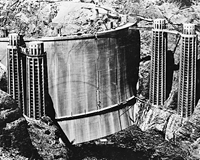
The last concrete is poured at the Hoover Dam site, four months before President Franklin Roosevelt dedicates one of the largest hydroelectric projects in U.S. history.
Hoover Dam was conceived in the early 1920s to irrigate desert, improve water supply to seven states, and generate electric power for burgeoning Southern California. The site (about thirty miles southeast of Las Vegas) was adjacent to Boulder Canyon, and the undertaking was christened the Boulder Canyon Dam Project. It was then the largest public-works program in U.S. history.

Construction began in 1932, and the first concrete was poured in June 1933. To prevent uneven cooling and contraction (which could cause cracks), concrete was poured in five-foot increments rather than continuously. A system of cold-water pipes sped the cooling.
The dam was built at considerable human cost: 112 workers died from accidents, heatstroke, or heart failure. A brief workers’ strike in 1931 failed, although working conditions improved in its wake. The Six Companies, which ran the project, began providing water to employees on a regular basis; probably a good idea, because temperatures routinely reached 120 degrees.
Hoover Dam was the world’s largest concrete structure until 1942, when the Grand Coulee Dam opened. The dam stands 726 feet high. Its seventeen turbines generate up to 2,074 megawatts of hydroelectric power. Damming the Colorado River also created Lake Mead, named for the dam’s project manager, Elwood Mead.
President Hoover’s interior secretary dubbed it Hoover Dam while visiting the site. The name stuck until FDR swept Hoover out of the White House in 1932. Roosevelt’s interior secretary changed the name back to Boulder Dam. President Truman, under pressure from Congress, restored Hoover’s name in 1947.—TL